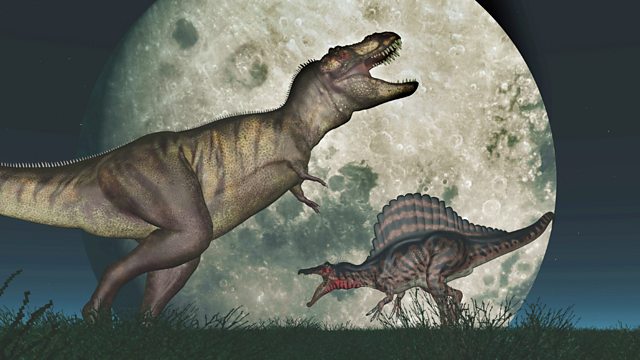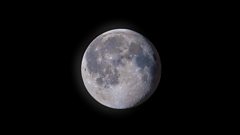How did the Moon affect the dinosaurs?
We know that the Moon’s gravity influences the Earth’s tides. But would its effects have been even greater in the past, when the two bodies were much closer?
The Moon and Earth are drifting gradually further apart. Every year the gap between them increases by a few centimetres. We know that the Moon’s gravity has an important effect on Earth - from controlling the tides to affecting the planet’s rotation - but slowly, imperceptibly, over billions of years, that influence will diminish as the Moon moves away.
For CrowdScience listener Tony in the UK that idea poses another question. What if we were to look back in time? What effects did the Moon have when it was closer to Earth? Would it counteract the planet’s gravity more so that, at the time of the dinosaurs, a Brontosaurus would weigh a little less that it would if it existed now?
It’s an intriguing question. And, given that it involves both the Moon AND dinosaurs, it’s one that’s got presenter Anand Jagatia really excited!
Anand begins his journey on Brighton beach on the South coast of the UK. He’s there to watch the full Moon rise - and get a few insights on Tony’s question - from astronomer Darren Baskill and astrophotographer (and cellist) Ivana Perenic.
Anand talks to Darren about the influence of the Moon’s gravity on Earth today. As they stand on the beach, with the sea lapping at their feet, they can certainly see its effect on the ocean tides. But did you know that the Moon also causes tides on the land as well? Every time it’s overhead the ground you’re standing on is higher by a few centimetres.
Professor Neil Comins, author of the book What If the Moon Didn’t Exist, explains why the tides are the reason the Moon is moving away from Earth – and it has been ever since it was first formed.
And how was it formed anyhow? We turn back time with Prof. Sara Russell from the Natural History Museum in London to discover one of the most dramatic events in the early history of our solar system... when two worlds collided.
And, of course, it helps to know what a dinosaur weighed in the first place. Anand turns to paleontologist Nicolas Campione, who’s been puzzling over the most accurate way to calculate the bulk of a Brontosaurus.
Contributors:
Dr. Darren Baskill, Astronomer, University of Sussex, UK
Ivana Perenic, Astrophotographer
Dr. Nicolas Campione, Paleontologist, University of New England, Australia
Prof. Sara Russell, Cosmic Mineralogist, Natural History Museum, UK
Prof. Neil Comins, Astronomer, University of Maine, USA
Presenter: Anand Jagatia
Producer: Jeremy Grange
Editor: Cathy Edwards
Production Co-ordinator: Ishmael Soriano
Studio Manager: Jackie Margerum
(Image: Tyrannosaurus Rex and Spinosaurus in front of the moon - stock photo Credit: MR1805via Getty Images)
Last on
More episodes
Previous
Clip
-
![]()
What was the Moon like at its birth?
Duration: 01:52
Featured
-
.
Broadcasts
- Fri 27 Sep 2024 19:32GMT91�ȱ� World Service
- Mon 30 Sep 2024 01:32GMT91�ȱ� World Service
- Mon 30 Sep 2024 04:32GMT91�ȱ� World Service Australasia, Americas and the Caribbean, South Asia & East Asia only
- Mon 30 Sep 2024 08:32GMT91�ȱ� World Service
- Mon 30 Sep 2024 12:32GMT91�ȱ� World Service East and Southern Africa, News Internet & West and Central Africa only
Podcast
-
![]()
CrowdScience
Answering your questions about life, Earth and the universe



